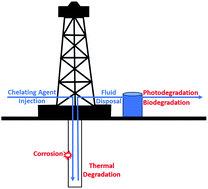From initial treatment design to final disposal of chelating agents: a review of corrosion and degradation mechanisms
Abstract
The use of aminopolycarboxylic acids (APCAs) is increasing rapidly in several industries because of their unique properties of chelation and their effectiveness in high-temperature conditions. One of the major design considerations before their application is their thermal stability and their corrosivity to tubulars, especially the ones used in the oil and gas industry. Their disposal is also an active topic of discussion. The coordination bond formed between the chelator and metal ions is strong and thus can have long-lasting effects on the environment in terms of the metal's bioavailability. Therefore, its biodegradation and photodegradation must be considered. There is a lack of a single source of these major decision criteria for the selection of suitable APCAs and this paper provides an outlet for researchers and industry professionals to further their understanding of APCAs. Several types of APCAs including EDTA, DTPA, HEDTA, GLDA, NTA, MGDA, CDTA, HEIDA, EDDS, and ASDA were reviewed for their corrosion mechanisms and corrosion rates to the most common tubulars used in the oil and gas industry. In some cases, these chelating agents were implemented as corrosion inhibitors as well. The degradation of APCA was divided into three major categories: thermal-, bio-, and photo-degradation. The influence of temperature, microorganisms, and light play an important role during and post-treatment. To fully understand these degradation mechanisms, literature from several industries including medical, mining, toxicology, hydrometallurgy, materials, environmental sciences, mineral sciences, and electrochemical sciences was examined and elucidated. This paper provides a unique perspective of design considerations with the application of the frequently used APCAs. This review connects literature from several industries and can provide an important step-change in the overall understanding of APCAs from the initial design phase to their final disposal and treatment.

- This article is part of the themed collection: 2022 Reviews in RSC Advances


 Please wait while we load your content...
Please wait while we load your content...